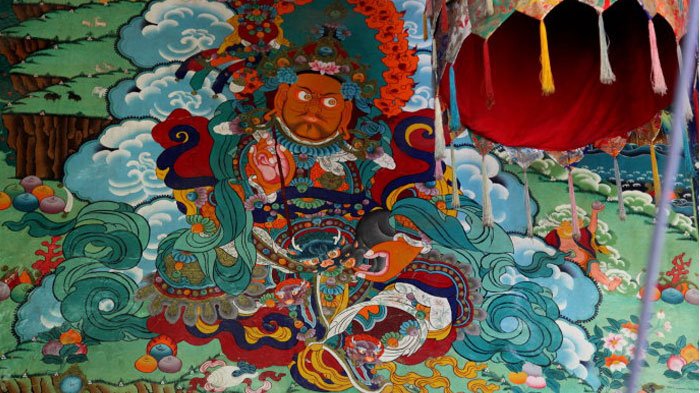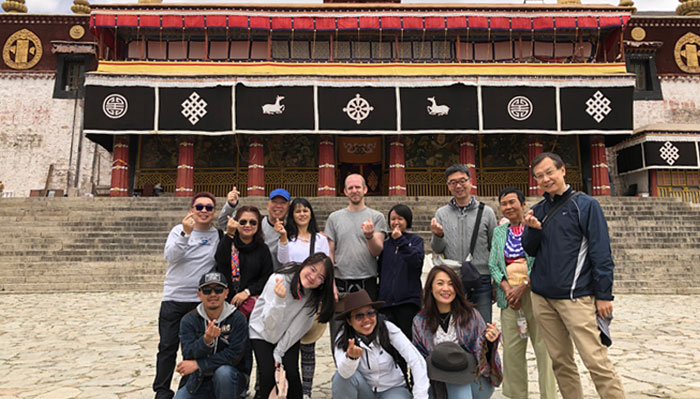
How to Be Respectful of the Buddhist Culture in Tibet
When visiting Tibet, you’ll inevitably notice that a large part of the culture lies in the dominant religion of the land: Buddhism. Approximately sixty-five percent of Tibetans abide by this faith. As a result, it has become so deeply woven into the society that it has become almost vital for tourists to come prepped with some understanding about the religion - that is if you plan on getting everything you can out of your trip, and who doesn’t want that?
So, to have a fully enriched experience while there - and ensure you’re being respectful of the locals, we’ve drummed up all you’ll need to navigate Tibet’s Buddhist-rich scene.
The Fundamentals of Tibetan Buddhism
History of Tibetan Buddhism
The type of Buddhism that is observed here is specifically referred to as “Tibetan Buddhism”, which is a melding of two ancient practices, Mahayana and Vajrayana, both of which are centered on achieving enlightenment.
In spite of its name, it actually first arose in India. Since its genesis, it has espoused the notion that becoming enlightened means either achieving Buddhahood or achieving a “rainbow body.” These two theories have their own unique imagery and also suggest different methods of achieving Nirvana, but both call for a virtuous, modest approach to life.
 Nyingma
Nyingma
Attaining “Buddhahood” implies becoming a Buddha will bring you everlasting bliss. To achieve such a status, you must purify your mind of the three major poisons: desire, aversion, and ignorance. In doing so, you will discover an end to your suffering, and this allows you to become complete and at peace with yourself.
The concept of acquiring a so-called “rainbow body” offers another route to reaching Nirvana. Apparently, this occurs when we are free from delusion, having attained all knowledge, which only happens when we are liberated from our own bodies at the end of life. When our physical bodies are freed from this earth and become pure light, before disappearing and giving way to light and rainbows, we are said to reach a state of bliss.
The approach that you take will depend on the branch of Tibetan Buddhism you ascribe to.
Tibetan Customs & Etiquette to Abide by
Now that you have some understanding of the basics of Tibetan Buddhism under your belt, these will help you understand why the following codes of conduct exist.
As a tourist to Tibet, you ought to show gratitude to the locals for opening up their home to you. To do this, ensure you are respecting their traditions and customs, by being cognizant of them and adhering to them.
Dress Properly when Visit Tibetan Buddhist Sites
No matter you visit a Monastery, a Temple, or a palace in Tibet, please make sure you refrain from sporting sensual clothing, or really anything that shows off your legs and arms.
 Dress properly when visit Tibetan Buddhist sites is also a way to show your respect for local custom.
Dress properly when visit Tibetan Buddhist sites is also a way to show your respect for local custom.
It is always preferred to dress modestly in this spiritual land. Women may wear skirts or dresses as long as they reach their calves—ankle-length is an even safer bet. Alternatively, ladies may wear long and loose trousers, as men may too.
You can also try to dress like a local Tibetan. We can provide you with a Tibetan traditional costume rental service. You can either visit these ancient monasteries in a Tibetan costume or leave a photo record of your visit to these famous landmarks in a Tibetan custom.
More Do’s and Don’ts When Visiting Tibetan Buddhist Sites
When you are going to visit a Tibetan monastery or other spiritual landmarks, here’s what you need to know in terms of how to conduct yourself there.
You should walk around the monastery, the temple, or the pagoda clockwise from left to right. You should also rotate the cylinder in a clockwise direction and never reverse it. If you follow the Bon religion or visit a Bon monastery, you should go counterclockwise.
Do not make loud noises inside the temple. Do not touch Buddha statues, scriptures, etc.
Don't take photos inside the temple halls (outside is okay).
Don't point at any images of lamas, Buddha statues, or other godly figures. Instead, do the motion to these with your outstretched, upward-facing palm.
Dining More Religious and Culture Taboos in Tibet
If you see someone sticking their tongue out at you in Tibet, don't be alarmed. Tibetans stick their tongues out as a sign of respect for their guests and clasp their hands together as a sign of blessing for others.
 Don't forget to ask for permission before taking the photo.
Don't forget to ask for permission before taking the photo.
If you want to take a picture of a Tibetan, especially a pilgrim doing prostration, please ask for permission before taking a picture.
In Tibet, there are many places where colorful prayer flags are hung with the Six True Words written on them, and Tibetans believe that if the prayer flags are turned over once, it means that they have been chanted once, so do not tug on them.
In some places, the custom of sky burial is still preserved, and the family of the deceased does not want visitors to watch, let alone take pictures, which is a sign of respect for the deceased.
Although Tibetans like to eat meat, they generally eat only beef and mutton and do not eat donkey, horse, or dog meat. Also, Tibetans do not eat fish.
Conclusion of being Respectful of Tibetan Buddhist Culture
In Tibet, Tibetan Buddhism has had a profound impact on Tibetan culture and the daily life of the local people. They are one of the most devout pilgrims in the world. Therefore, when traveling to Tibet, it is suggested to have some knowledge of Tibetan Buddhism so that you can respect the lifestyle of the local people.
Some of the behaviors of Tibetans may seem different to us, but these are habits and customs that have developed over thousands of years under the profound influence of Tibetan Buddhism.
In Tibet, especially when visiting monasteries, temples, and other religious sites, it is important to strictly follow local customs, dress appropriately, and follow appropriate routes, such as walk in a clockwise direction while doing the kora, or counterclockwise in the case of Ben religion.
There are also many holy objects, such as prayer flags and mani stones everywhere in Tibet. Do not touch them.
If you have any questions during your Tibet tour, you can ask your local Tibetan guide. Our local Tibetan guide will be happy to introduce you to the authentic Tibetan culture and give you a better understanding of the real Tibetan.

Kham Sang is responsible and honest with more than six years of guide experience in Tibet.She has strong interpersonal skills and can communicate effectively with tourists.


.jpg)




0 Comment ON "How to Be Respectful of the Buddhist Culture in Tibet"